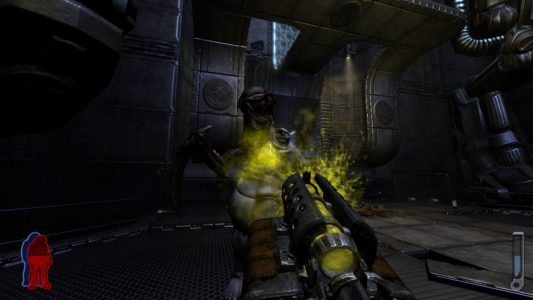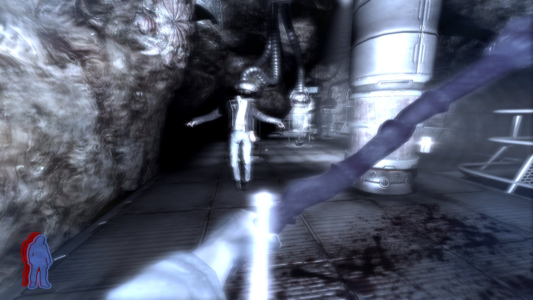
Prey
Written by: Rik
Date posted: July 9, 2016
- Genre: Action
- Developed by: Human Head Studios
- Published by: 2K Games
- Year released: 2006
- Our score: 6
It may all have happened more than 20 years ago now, but I remember pretty clearly that Prey was initially touted as a rival of the original Quake. iD had Quake, Epic Megagames had Unreal, and 3D Realms had Prey, and between them they were going to represent the next generation of first person shooters in the mid-late 90s. Or that was the plan, anyway. In the end, Quake beat them both by virtue of actually being released in a more timely fashion. 3D Realms had a game to pit against Quake, but it was Duke Nukem 3D, which – whatever its merits – wasn’t on the same technical level. Unreal wasn’t released until after Quake 2 had been and gone, while Prey‘s stop-start development meant it didn’t see the light of day until 2006, after the fourth Quake game (but still – ho ho – before Duke Nukem Forever).
In the post Half-Life FPS tradition, Prey is a game in which your character’s initial humdrum existence is shattered when an unexpected turn of events carries him into a rather sticky situation. In this case, the character is Domasi “Tommy” Towadi, the humdrum existence is life on a Native American reservation, with which Tommy is rather bored and disillusioned, and until the unexpected turn of events, the opening scenes involve him whiling away time in a bar listening to 70s rock, while simultaneously avoiding the attentions of his grandfather (who keeps harping on about tradition) and trying to persuade girlfriend Jen to leave and seek pastures new. After that, to say too much more would be to spoil a rather fabulous opening sequence that must count as one of the best I’ve ever come across (so I won’t).
From that point on, Prey’s early exchanges are very much a series of WTF moments, with you most likely sharing your character’s befuddlement at the rather grisly and horrifying events unfolding in front of your eyes. It’s a world of goo, gristle and sinew, with anus-shaped walls and doors that look like, well, lady parts. I guess I was expecting a gory sci-fi shooter, but not quite like this: it reminds me of renting Event Horizon as a teenager and expecting an Aliens-style romp, only to be mildly perturbed when everyone went mad and started pulling their own eyes out. (I’ve never quite trusted Sam Neill since then). You’ll notice that Tommy swears fairly gratuitously, but under the circumstances, it’s actually a perfectly normal reaction to what’s going on, and you may find yourself wanting to do the same at times. To create a sense of unease without resorting to shocks and scares is, I suppose, a good thing, though.
I hope it’s not spoiling too much to say [it isn’t, there are screenshots – FFG reader] that you’ll be battling aliens and other creatures throughout the game, and as you begin with only a wrench, you’ll have to make use of various alien weapons along the way. In a manner consistent with the rest of the world, they pulse and ooze, a mix of biology and technology. Fortunately, they also handily replicate the functions of your standard FPS arsenal: there’s a pistol that doubles as a sniper rifle, a machine gun with grenade launcher, a shotgun, and a rocket launcher. One nod to originality is the leech weapon that can harness power from different sources, and can be used to shoot ice, electricity and, er, red blobby things.
A further twist is that you’re urged by your grandfather, in a series of dream-like sequences, to embrace your ancestry and harness special powers in the process. Firstly, this secures you the help of your childhood pet hawk Talon (a possible reference to Talon Brave, the proposed name of Prey‘s original 90s protagonist), who can translate alien language on monitors and switches, attacks your enemies with gusto, and gives hints as to where to go next. It also means you unlock the power of the spirit walk, in which you leave your physical body behind (and vulnerable to attack) and are able to pass through forcefields (but not doors), activate switches, traverse previously invisible walkways, and sneak past enemies (with whom you can engage, but with only the use of your spirit bow rather than the physical weapons you’ve collected along the way).
The introduction of Talon as your sidekick helps the game maintain a “don’t tell me, show me” approach, which works for the most part, especially when you figure out that frequently the answer to getting stuck is to enter spirit walk mode (a handy symbol that appears on the floor or wall is also a pretty heavy hint that you should do so at that particular location). Still, there are moments when you become horribly lost (in one case, for me, it was the result of a bug – see The Dark Harvester for more).
The final twist is that you can’t die. Losing physical health simply transports you to spirit mode and an area where you shoot wraiths with your spirit bow to build up your physical and spiritual health before returning to your physical body. If you’re concerned about beating a section properly in the good old fashioned quicksave-and-reload fashion, that’s available too (it is part of the enjoyment of these things, I feel, to have the sense that you did things properly). Having said that, there are times later in the game when you can’t easily imagine how you might have beaten a boss without making use of this facility, and doing so does give these battles a slightly inconsequential feel.
Elsewhere, there are physics and portal-based puzzles, with a lot of jumping through holes, and turning the ceiling into the floor (and vice versa). With the exception of one section which involved being stuck in a giant cube, there aren’t too many head-scratchers, and in general the portals seem mainly to be an excuse for baddies to warp in from nowhere more than anything else. Sadly, I haven’t gotten around to playing either of Valve’s Portal games yet, but from what I’ve seen and read about them, I’m guessing they make more creative use of the concept than what’s on offer here.
There’s much to like about Prey: the setup is interesting, and after you’re blown away by the opening scene, the environment feels unsettling to inhabit and there’s a feeling of genuine discomfort as exactly what’s going on becomes more and more apparent. Tommy, too, is a different kind of hero, and there seems to have been a genuine attempt to use his Cherokee heritage in an interesting and relatively progressive way (I’m not the best person to judge on this, though: opinions on ‘the internet’ seem to be mixed, but you can tell some thought has gone into it at least).
Some of the levels are really impressive in terms of conveying huge open spaces and structures, and there are plenty of impressive moments. I also liked the way that bits of the bar appear in random places in this alien environment, an occasional reminder of the real world left behind (the arcade machines still work, too). Along the same lines, you’re sometimes led towards quieter areas and invited to listen to snippets of a talk radio show back on Earth, which also give a sense of what’s going on beyond Tommy’s own story. And, of course, it’s awesome to have a hawk as a sidekick.
However, at the same time, a lot of the core action is rather uninspiring, and for much of the game, it largely consists of the same grunts jumping out of portals with a growl. Towards the end these exchanges are replaced by a succession of rather bullet spongey enemies and bosses. With the exception of lobbing a grenade at a turret to destroy it before it can power up (which I really did like) I found most of the combat fairly unsatisfying. By far the worst bits are the shuttle sequences, in which you use an alien craft to traverse the greater open areas in some levels. Navigation isn’t always easy, and combat is tiresome, and you’re often left wondering who is shooting at you, and from where.
Prey struggles for momentum. There are good bits, there are not-so-good bits, and you could argue that the most memorable come when you’re not actually participating in the action. By the time you get to the end (a triple whammy of boss battles, each a mixture of exciting spectacle and wearisome blasting) there’s also a sense that perhaps the full potential of the story hasn’t quite been realised. In trying to dance around spoilers, I’ve sort of prevented myself from talking about the good stuff, which is why this perhaps reads a little on the negative side, although – and I don’t know if my expectations were set a little too high – I have to say was a little disappointed overall. Still, it’s fairly short and sweet, and there’s enough of interest to sustain a weekend’s blasting at least.






 Posts
Posts